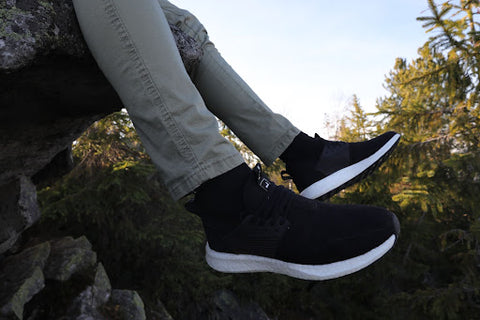If you run regularly, you must have a very good idea about the importance of the right shoes. The right shoe can make or break your daily cardio. Moreover, it is simply much easier to reach your goals when your feet and legs are not constantly aching and uncomfortable.
Breathable, lightweight, well-cushioned, responsive, and waterproof running shoes are the holy grail of running. Not only do they provide a great foot environment from a health perspective, but they also enrich the running experience.

Before we move on to discussing the lifespan and health of your running shoes, you might want to check out Loom’s waterproof running shoes if you’re looking for a new pair.
The Average Lifespan of Running Shoes
The lifespan of your running shoes cannot be determined in units of time. Here are some factors that can affect the durability of your shoes:
Mileage
Running shoes should be replaced after an average of 400 miles. However, we can establish a range of 250 to 500 miles for different types of shoes. Lighter and flimsier shoes must be replaced after 250 to 300 miles, whereas stronger and sturdier shoes can serve their purpose longer.
You can keep track of your mileage using a smartwatch or your phone. You can also calculate it manually by multiplying the average daily distance you cover by the number of days you run.
Terrain
Although mileage is a reliable marker, it is not absolute. Running shoes get worn out faster on rugged terrain and last longer on smoother surfaces.
Gait
People who run with good posture, have a steady gait and foot placement, and maintain perfect balance often find their shoes last longer. On the other hand, if you inherently walk with an altered gait cycle, your running shoes are likely to get ruined faster.
Body Weight
A higher body weight means greater force per unit area. Very tall or overweight people find that their shoes need replacement quicker.
Upkeep
Quite understandably, shoes that are well taken care of stand the test of time. They also look clean and can be in vogue longer. We’ll get to more on this later!
Signs Your Running Shoes Need Replacement
It is ill-advised to keep running in worn-out shoes and pushing them past their limit. You can develop severe injuries, especially in the ligaments and tendons on your feet, by exerting your shoes beyond their capacity.
Here are some signs to look out for to replace your running shoes timely.
1. Progressive Pain and Discomfort
Are your running shoes starting to feel uncomfortable? Do your feet hurt progressively more after a long run? Are you often sore after prolonged standing?

Well, these are all indicators that our shoes are not doing their job anymore. Here are some of the possible reasons for this.
Inflammation
Prolonged stress on the wrong areas of your feet and legs leads to inflammation. Many people develop conditions like tendinitis, plantar fasciitis, and muscle cramps from wearing the wrong shoes.
In case an inflammatory condition develops and is left unattended, it can cause tissue damage. This takes a long time to repair and heal and still proves to be a cause of pain on overexertion months down the line.
Complications such as these can interfere with your exercise and cardio and make the activity difficult.
Friction Injuries
Moreover, many people start experiencing friction abrasions and burns when their shoes are no longer in good shape. This means that the material has been distorted to chafe and rub in the wrong spots.
These abrasions can even lead to blisters and extreme discomfort while walking and running.
Infections
Poor breathability in a shoe can lead to fungal infections such as Athlete’s foot. This is especially likely if your feet sweat a lot and you wear the shoes for a prolonged time.
Prevention is always better than treatment. So when you begin to feel the first signs of discomfort, you must make sure to replace your running shoes.
2. Loss of Stability
Good functional running shoes grip your foot just right, allow plenty of room for flexible movement, and help you maintain balance. If you are repeatedly tripping and are uneasy finding the right balance, the chances are that your shoe has run its course.
If you feel that your ankle movements are either restricted or unsupported and your foot twists easily on uneven surfaces, the culprit may just be a worn-down running shoe. Similarly, a worn-out shoe can lead to impaired balance.
This loss of stability can lead to poor posture, poor performance, and poor rewards with time. It can quickly deteriorate the quality of your running experience. The immediate consequence can be severe injuries due to a fall or slip.
Therefore, if you think your running shoes are no longer supporting you properly, it is time to throw them out.
3. Poor Cushioning
During the heel strike portion of your gait cycle, force is transmitted to your pelvis. Running further increases the intensity of the impact of your heel strike. For this reason, adequate shock absorption is a must for good running shoes.

Adequate midsole cushioning provides both arch support and shock absorption. The midsole cushion should be supple and soft. Toughness indicates that it is nonfunctional.
The cushioning can become reduced with wear and tear. Poor shock absorption can lead to a sharp and jarring force transmitted to your pelvis, especially the lower back. This can also radiate all the way to the back of your shoulders.
Have you been suffering from soreness in your legs and continuous back pain? Does your tailbone hurt when sitting or while performing any strenuous task? Chances are that your discomfort is caused by impaired force transmission and poor cushioning effect.
A long-term consequence of this can be bad posture. Your body naturally bends and twists to accommodate any pain you may be feeling so that you can run as comfortably as the situation allows. When you leave it unacknowledged, it has the potential to ruin your posture.
4. Worn Out Soles
The soles of your shoes provide you with a good grip on all kinds of surfaces. The purpose of the treads is to help you avoid slipping on smooth floors and provide anchorage on uneven terrain. The soles determine the functionality of the shoe.
The soles are also the last part of the shoe to show wear and tear. So if the sole looks and feels battered, a new pair of running shoes is definitely due.
Moreover, worn-out treads are a surefire sign that you have used your running shoes way past their replacement age. Smooth soles can also be quite dangerous, and they increase the risk of falling and injuring yourself.
Loom’s waterproof running shoes have soles with specifically designed treads that prevent slipping in wet and muddy areas. The shoes will lose their function of providing you anchorage on slippery surfaces after too much wear and tear.

5. Uneven Wear and Tear
Do you notice that your shoes are more worn out in certain areas as compared to others? This may be because of abnormal foot positioning.
Some people’s foot placement can be uneven from the start. Some overpronate, and others might under-pronate. All this causes the wear and tear to begin in more weight-bearing areas.
Continuing to wear these running shoes can be harmful. Your foot further adapts to the uneven wear, worsening foot placement. You also risk developing severe back pain.
It is a good idea to replace your running shoes as soon as you notice uneven wearing.
Also read: Customers’ Pick! Best Walking and Running Shoes for Overweight Walkers
Caring for Your Shoes
Some people’s shoes last longer than others. When you provide adequate care to your shoes, they manage to remain functional for a longer period. Of course, they would still require replacing at some point.
Additionally, not only does caring for your shoes improve their lifespan, but it also keeps them looking spick and span. Here are some tips for taking care of your running shoes.
- Wear them only while running
- Invest in a new pair and alternate them with the second pair to compare the comfort of both shoes
- Clean them regularly, making sure there is no grime in the treads and on the upper
- Wash them if they are washing machine friendly
- If you use insoles, make sure to take them out and dry them
- Air-dry your shoes
- Keep them in the sun for a little while from time to time
- Always put them on and take them off the right way to avoid overstretching and tearing
In addition to this, many people replace the insoles to make their shoes last longer. This is a good idea in case you are unable to invest in a new pair immediately.
The Bottom Line
The right shoes will save you a lot of pain, injuries, and medical issues. In addition to that, they will make your daily run much more enjoyable and productive. Companies design running shoes specifically to target all runners’ issues, and a good pair adds immensely to your comfort.
Comfortable running shoes, therefore, not only keep your spirits elevated but also enable you to keep running long-term. Replace your shoes whenever you notice one of these signs. We hope you found this article helpful.


